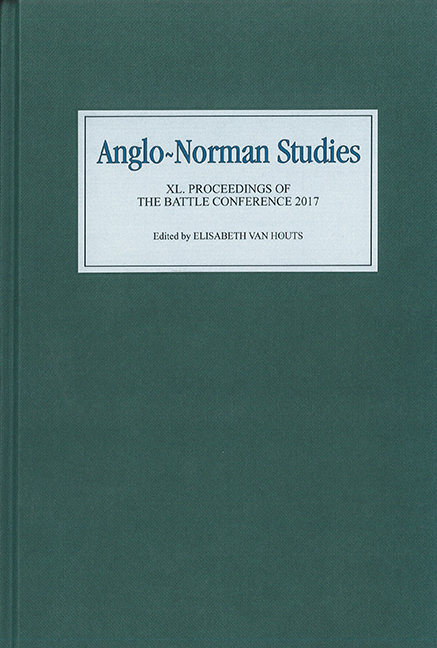Book contents
- Frontmatter
- Contents
- Illustrations and tables
- Editor's preface
- Abbreviations
- The R. Allen Brown Memorial Lecture, 2017
- The R. Allen Brown Memorial Lecture, 2016
- The Marjorie Chibnall Memorial Essay, 2017
- Becket vult: the Appropriation of St Thomas Becket's Image during the Canterbury Dispute, 1184–1200 (The Marjorie Chibnall Memorial Essay)
- La Bataille de Bouvines reconsiderée
- Abbot Peter the Venerable's Two Missions to England (1130 and 1155/1156)
- La production manuscrite anglo-normande et la Bible d'Herman de Valenciennes: usage et réception d'un livre vernaculaire (xii e–xiv e siècles)
- Ralph Niger and the Books of Kings
- From Captivity to Liberation: the Ideology and Practice of Franchise in Crusading France
- Daughter of Fulk, Glory of Brittany’: Countess Ermengarde of Brittany (c.1070–1147)
- The Idea of ‘Empire’ as Hegemonic Power under the Norman and Plantagenet Kings (1066–1204)
- Child Kingship and Notions of (Im)maturity in North-Western Europe, 1050–1262
- Note: A Micro-Economy of Salvation: Further Thoughts on the ‘Annuary’ of Robert of Torigni
Becket vult: the Appropriation of St Thomas Becket's Image during the Canterbury Dispute, 1184–1200 (The Marjorie Chibnall Memorial Essay)
from The Marjorie Chibnall Memorial Essay, 2017
Published online by Cambridge University Press: 17 July 2018
- Frontmatter
- Contents
- Illustrations and tables
- Editor's preface
- Abbreviations
- The R. Allen Brown Memorial Lecture, 2017
- The R. Allen Brown Memorial Lecture, 2016
- The Marjorie Chibnall Memorial Essay, 2017
- Becket vult: the Appropriation of St Thomas Becket's Image during the Canterbury Dispute, 1184–1200 (The Marjorie Chibnall Memorial Essay)
- La Bataille de Bouvines reconsiderée
- Abbot Peter the Venerable's Two Missions to England (1130 and 1155/1156)
- La production manuscrite anglo-normande et la Bible d'Herman de Valenciennes: usage et réception d'un livre vernaculaire (xii e–xiv e siècles)
- Ralph Niger and the Books of Kings
- From Captivity to Liberation: the Ideology and Practice of Franchise in Crusading France
- Daughter of Fulk, Glory of Brittany’: Countess Ermengarde of Brittany (c.1070–1147)
- The Idea of ‘Empire’ as Hegemonic Power under the Norman and Plantagenet Kings (1066–1204)
- Child Kingship and Notions of (Im)maturity in North-Western Europe, 1050–1262
- Note: A Micro-Economy of Salvation: Further Thoughts on the ‘Annuary’ of Robert of Torigni
Summary
On the night of 25 November 1186, Andrew John, a monk of Christ Church Canterbury, had a vision. Saint Thomas Becket appeared before him, bade him rise from his bed and follow him into one of the towers adjacent to the choir. There, the blessed martyr showed Andrew John a large Catherine wheel, spitting blue flames. Archbishop Baldwin appeared and leant on three swords to test their strength. Having chosen a sword, he summoned Prior Honorius, the head of the monastic community. ‘I wish’ said Baldwin ‘to destroy this new work, [the recent renovations to Canterbury cathedral in honour of Becket] and for this purpose I have made this wheel, but without you I cannot move it’. The dismayed prior obeyed and summoned other monks to help him. Andrew John begged Becket to intervene. The saint drew his sword, inscribed with letters of gold, and Archbishop Baldwin vanished. Becket then gave the sword to Andrew John, showing him the inscription gladius beati Petri apostoli. He ordered the monk to present the sword to the prior, who should use it to destroy the Catherine wheel. Andrew John had this vision three times before he ventured to tell the prior. Honorius immediately understood its meaning. The Catherine wheel was Baldwin's new church, and the sword (representing appeal to Rome) was the weapon with which the convent could defeat this evil plan.
Behind all this lay the great ‘Canterbury dispute’: the outcome of a plan of Archbishop Baldwin's to build a collegiate church for secular canons, to be dedicated to Thomas Becket. The aim was to provide a source of income for the clerks of the archbishop's household, thereby decoupling the archbishops from their dependence upon a monastic cathedral chapter, in effect undoing six hundred years of the work of Augustine, Dunstan, and Lanfranc. The initial site selected for the new foundation lay at Hackington, just outside Canterbury, although in due course Lambeth was to emerge as an alternative. The monks of Christ Church believed that the archbishop's plan would not only weaken their status as the cathedral chapter but, in short order, threatened to deprive them of the relics of their recently acquired but most beloved saint, Thomas Becket.
In 1162, the monks had greeted Becket's election with indifference, and his subsequent disputes with Henry II with outright scorn.
- Type
- Chapter
- Information
- Anglo-Norman Studies XLProceedings of the battle conference 2017, pp. 63 - 76Publisher: Boydell & BrewerPrint publication year: 2018
- 1
- Cited by



